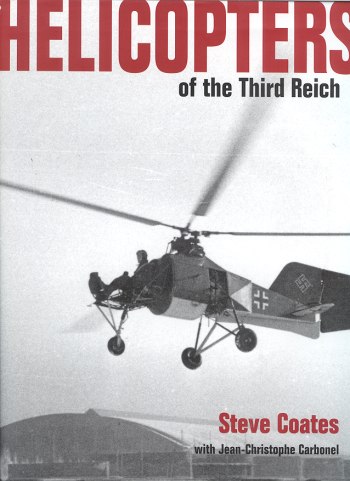 There are those
modelers out there who are really into a special variety of aircraft with moving
wings or helicopters. Most aviation enthusiasts are not aware of early types.
Probably the Bell 47 of 'MASH' and 'Whirlybird' fame on TV are where most of us
were introduced to early helos. Yet the very early helicopters were basically
being developed in the US and Germany. Germany in many ways had a head start on
the US, though that gap was closed significantly by the end of the war.
There are those
modelers out there who are really into a special variety of aircraft with moving
wings or helicopters. Most aviation enthusiasts are not aware of early types.
Probably the Bell 47 of 'MASH' and 'Whirlybird' fame on TV are where most of us
were introduced to early helos. Yet the very early helicopters were basically
being developed in the US and Germany. Germany in many ways had a head start on
the US, though that gap was closed significantly by the end of the war.
Both in the US and Germany, as well as other parts of the world,
companies used the autogiro, or more specifically, the autogiros of Juan Cierva
as an initial basis to get acquainted with rotorcraft in general. In fact, the
first rotorcraft in Germay were Cierva C.19 and C.30 autogiros, purchased
by the Luftwaffe for evaluation. Eventually Focke-Wulf did produce several
Cierva C.30s under license as the FW C.30.
Interestingly enough, development of these craft was quite
different in the US and Germany. In the US, Sikorsky was working on helos with a
single main rotor and a small tail rotor to offset the problems of torque. In
Germany, this problem with torque was nulled by using intermeshing twin rotors
or two widely spaced ones. The initially successful German helicopter, the FW-61
used widely spaced main rotors simply because Heinrich Focke didn't want to
duplicate the set-up used by Sikorsky!
How Focke (of Focke-Wulf fame) got into helos is a story in and
of itself. He became interested in helicopters about the same time that he was
ousted from his own company in a hostile take-over by Kurt Tank, a noted
designer himself. Tank basically told the board of directors that if they wanted
him to work for the company, Focke had to go. Part of the deal was that Focke
would be allowed to continue his helicopter using the Focke-Wulf facilities
until such a time as he could develop his own. He partnered with Gerd Achgelis
to form Focke-Achgelis in 1937, a company that concentrated totally on
helicopters.
Meanwhile, the other eventual big player in the game, Arnolt
Flettner, started with an autogiro and eventually developed it into a
rotor-driven helicopter (autogiros have a free rotor). Flettner chose the twin
intermeshing blades as the way to cancel out torque. Whereas Focke-Achgelis
developed a 'heavy lift' helicopter, Flettner's design was much smaller and
lighter.
There were other players in the game such as Rieseler, Nagler,
and Dobelhoff, but they never got past the prototype stage, where both
Focke-Achgelis and Flettner managed to get production aircraft operating, though
mostly with test units. The fact was that the German high command never saw the
helicopter as being a positive asset to the war effort so funding and manpower
for them was sporadic. In retrospect, like the British, helicopter development
in Germany should have stopped once the war began as such a revolutionary
aircraft could not have possibly made a major contribution to the war,
regardless of how useful they might have been.
Since the FA-223, FA-330, and FL-282 were the most developed of
all types, the book concentrates on them more than the others. There are the
usual stats on the various aircraft built as well as post war use by Allies and
other developments that were being studied. This includes some pretty fanciful
paper projects that would have been incredible aircraft. Unlike other Classic
books, this one only has one full color art drawing, though there are several
color photos taken after the war of some of the captured aircraft.
Bottom line is that nowhere will you find more information on
German helicopters and operations during WWII than here. It is a book that every
helo enthusiast and Luftwaffe modeler should have on their shelves.
Very highly recommended
Review book courtesy of
 ,
where you can order your copy of this and many other superb aviation and
modeling books.
,
where you can order your copy of this and many other superb aviation and
modeling books.
If you would like your product reviewed fairly and quickly by a
site that has over 200,000 visitors a month, please contact
me or see other details in the Note to
Contributors.
 There are those
modelers out there who are really into a special variety of aircraft with moving
wings or helicopters. Most aviation enthusiasts are not aware of early types.
Probably the Bell 47 of 'MASH' and 'Whirlybird' fame on TV are where most of us
were introduced to early helos. Yet the very early helicopters were basically
being developed in the US and Germany. Germany in many ways had a head start on
the US, though that gap was closed significantly by the end of the war.
There are those
modelers out there who are really into a special variety of aircraft with moving
wings or helicopters. Most aviation enthusiasts are not aware of early types.
Probably the Bell 47 of 'MASH' and 'Whirlybird' fame on TV are where most of us
were introduced to early helos. Yet the very early helicopters were basically
being developed in the US and Germany. Germany in many ways had a head start on
the US, though that gap was closed significantly by the end of the war.